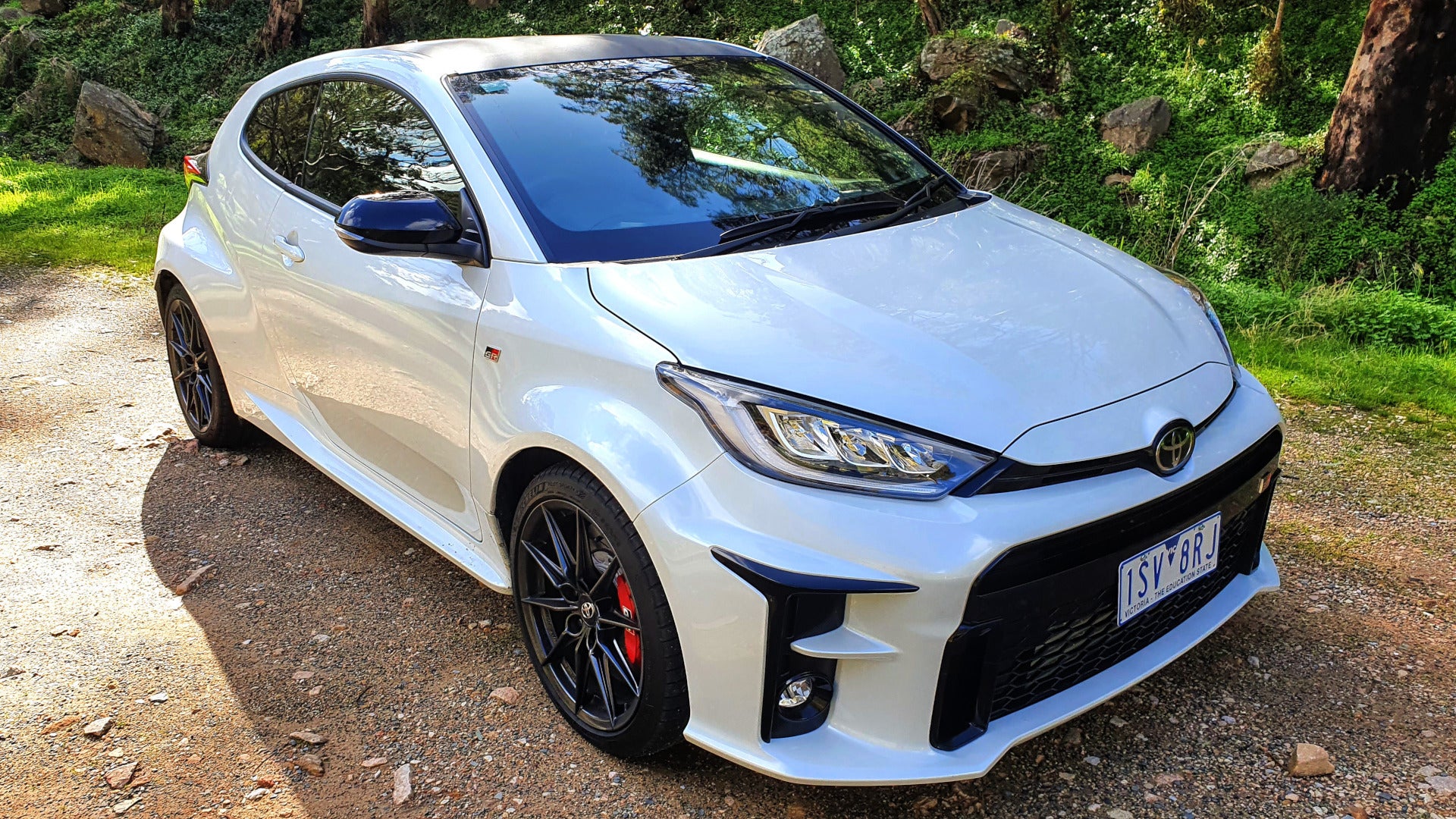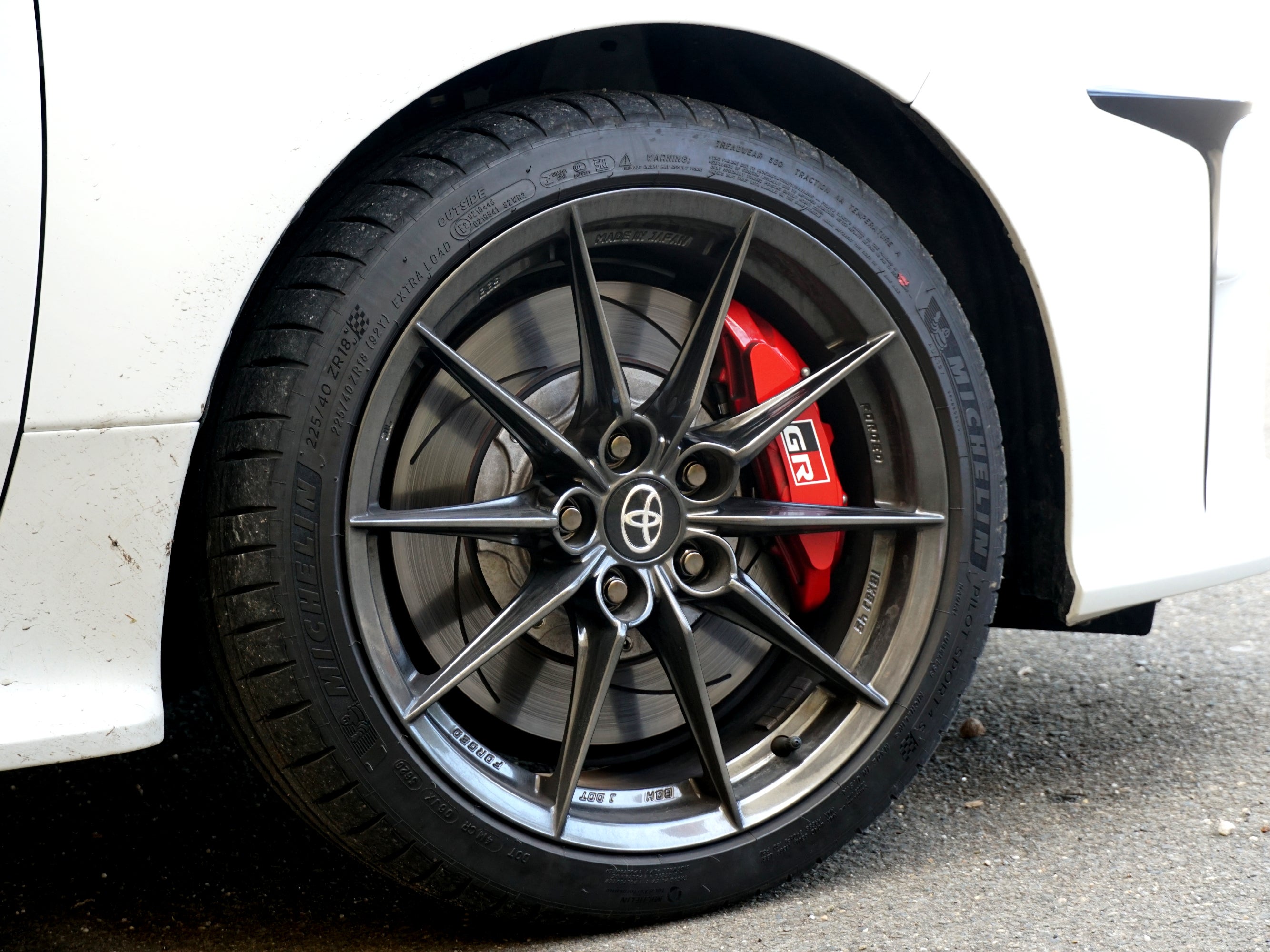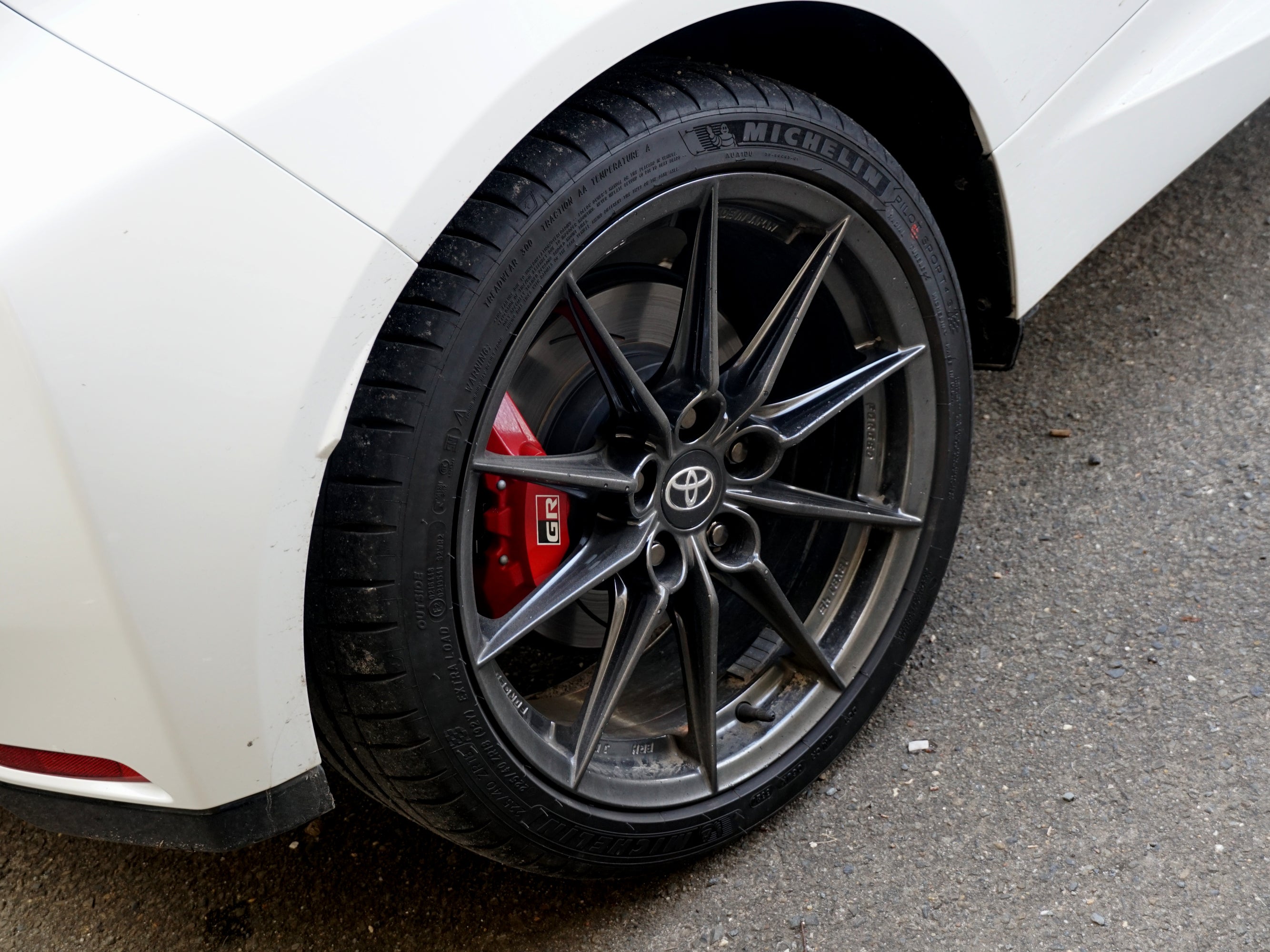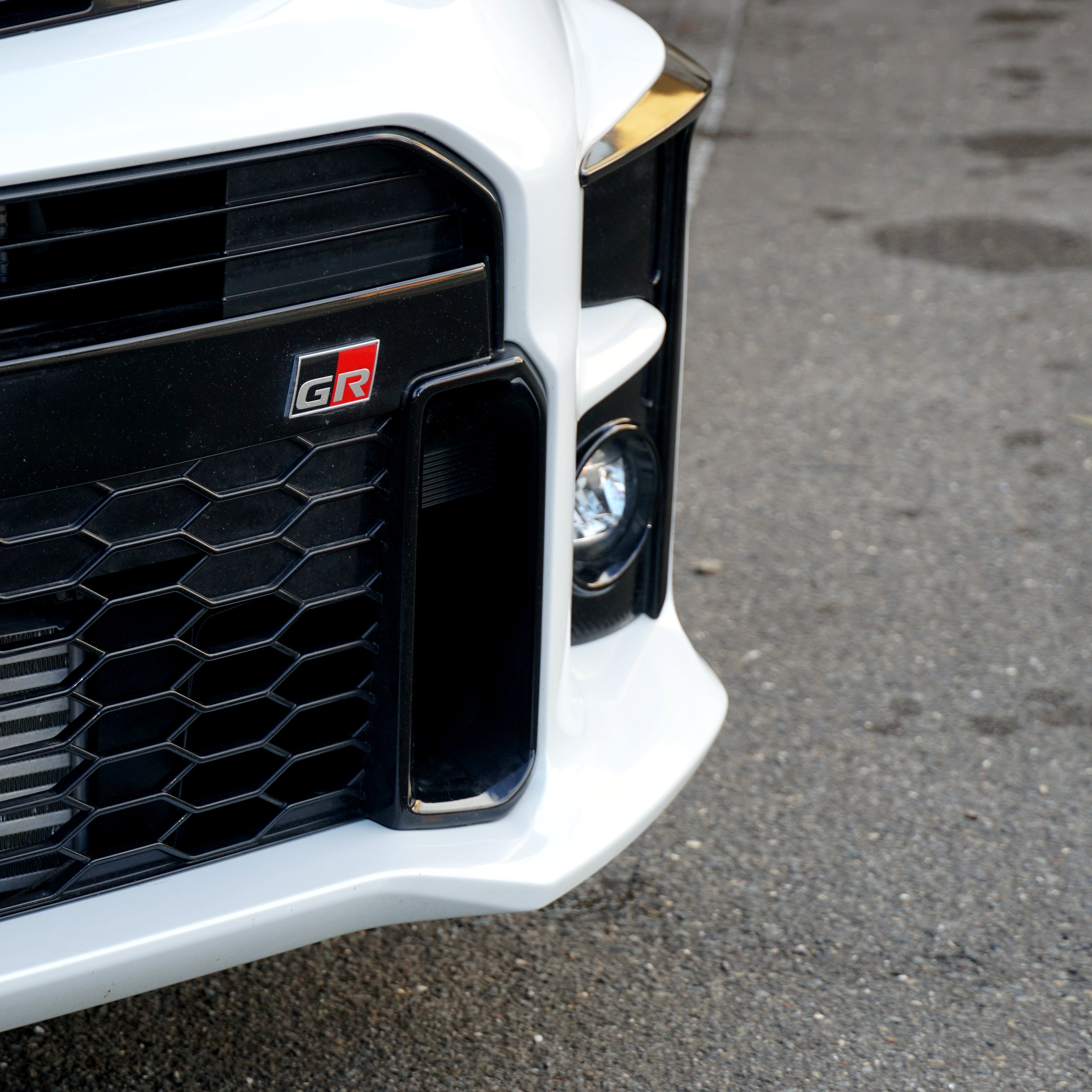Toyota has worked hard in recent times to bring back its performance edge, with cars like the 86 and the return of the fabled Supra. Both nameplates have found their fans, but both have also been treated as imperfect specimens, one chided for its lack of power, the other for its breeding. The 2021 Toyota GR Yaris rights those wrongs.
The average passerby might just see a commuter car, but those who know, know. Utter the words “homologation special” and watch for goosebumps spring up on any enthusiast within earshot. Open the door, get behind the wheel, and you’re under no misapprehension—this Toyota is built for more than just groceries.
The Toyota Yaris is the smallest entry in the automaker's lineup. Slotting in below the revered Corolla, it brings much the same ethos—simplicity, usability, and dependability—in a cheaper, smaller package. The replacement for the Toyota Echo, it entered service in 2006 and was primarily seen in five-door hatch format in the U.S before it was canceled for the 2021 model year. The GR Yaris spawned from this humble base, and yet has become so much more.
The GR Yaris was built as part of Toyota’s return to the World Rally Championship. The base model Yaris wasn’t exactly what you'd call "rally-spec," and Gazoo Racing, Toyota’s performance arm, had certain needs it couldn’t meet. Thus, the rear of the GA-C Corolla platform was grafted onto the front of the GA-B Yaris platform and birthed the GR Yaris we know today. Taking this route enabled the engineers to fit features crucial to building a competitive rally car, like double-wishbone suspension at the rear and Toyota's new GR-FOUR all-wheel-drive system.
WRC regulations state manufacturers must produce 25,000 examples of the base model car in a continuous 12-month period for it to be eligible for competition. There are restrictions on how much the race vehicle can be modified from the stock road car, too, which means manufacturers are forced to put the good stuff in the road car if they wish to field a competitive entry. We, the consumers, reap the benefits. It’s for these reasons we have a turbocharged, all-wheel-drive performance car bearing the Yaris name.
Visually, the car is highly appealing to the tunerboi inside. Forged BBS wheels with grippy low-profile rubber, perfectly filling the pumped-up guards? It's a look, boo, and I’m tired of pretending it’s not. The gaping front intakes and purposeful grille also mean business. Glossy black rear trim panel combines well with the carbon fiber roof and hatch spoiler to give the rear a suitably serious aesthetic, too. The twin exhausts are also a tell that this isn’t yo’ grandpappy’s Bingo ride, neither.
Upon opening the door for the first time, you’re greeted with an interior that makes it clear you’re getting into a naughty little sports car. Naturally, there are the heavily-bolstered sports seats complete with red stitching, because hey—we all know red means “fast," right? The wheel is leather-wrapped and bears a big GR logo on the center spoke. Fire up the engine with a touch of the button, and you’ll be surprised to hear an almost truck-like rumble and clatter as the three-cylinder barks into life.
In the short time I had the car, I wasn’t able to fully exploit its capabilities; a surprise pandemic lockdown meant I got just three hours to drive it through the hills. I was amazed at how quickly I was at ease, though. It wasn't long before I was leaning on it through few corners and punching the throttle to roar out of a bend.
If there’s one thing that stands out about the GR Yaris, it’s how familiar it feels right away. The clutch is well-weighted and the shifter is solid, though neither is so angelically perfect that you’d obsess over it. The steering too, is taut and quick, and you’re never left guessing how much lock you’ll need in a corner. Once I’d adapted to the seating position, which is a little higher and more upright than you might expect, I quickly felt comfortable.
On a winding country road? Well, it’s just bloody marvelous.
In the top-of-the-line Rallye spec with limited-slip diffs front and rear—and riding on sticky Michelin Pilot Sport 4S tires—the thing just grips and goes. It’s stiffly sprung and nicely directional without being excessively twitchy. In Normal mode, it’s very neutral through a corner. It presents none of the frustrating understeer of a front-wheel-drive car, though neither does it wag the tail. You might see a little more of the latter if you throw it into Track mode with 50:50 torque split, but in any case, it never feels squirrelly or loose. Put down the power and hang on, and the GR Yaris simply grips and pulls you through faster than you thought you could go. Of course, if you must hang it all out, Sport mode will split the torque 30:70 to the rear so you can have a little extra fun.
The car has a very point-and-squirt feel to it. You don't even have to floor it; squeeze the pedal at corner exit and that magnificent turbo kicks in. The engine growls and starts dragging as much road under the car as it possibly can, like a 3-year-old stuffing bubble gum tape down their throat seconds before almost choking.
The boost is a vampire; open the throttle and invite it in. You’ll instantly know about it. Above 2,300 rpm, the engine is always on the boil and ready to thrust you towards the horizon. The only decision you have to make is whether or not you really want to go there. The brakes are always available if you change your mind.
With 356mm front rotors—or 14 inches, which are even bigger than those on the current Supra—the GR Yaris has no problem bleeding off speed in a hurry. I was just being cautious, as I didn’t want to bin Toyota’s lovely press car by overcooking it on a rain-slicked road on a dreary afternoon. With a little practice and the right heel-toe technique, though, it feels like this car could be devastatingly quick in the right hands. Of course, there’s also the iMT system that will help blip the throttle for you, if you prefer.
The noise is a polarizing issue, of course, but one that I nonetheless enjoyed. No bones about it: The GR Yaris does feature fake engine noise and there’s no way to disable it without using third-party tools. Comparison videos on YouTube show it’s a relatively authentic sound that’s piped in, amplifying the engine’s real noise rather than synthesizing something false entirely. Perhaps more interesting is the timbre of the three-cylinder motor. It’s surprisingly deep and with an almost agricultural flair—in a very pleasing way, that is. It’s certainly no high-rpm wailer; the G16E-GTS has more of a throaty, guttural growl as you punch up towards the redline.
Rated at 268 horsepower and weighing 2,822 lbs, the car falls into a similar power-to-weight range as sports models from the mid-size class—think the VW Golf R and Subaru WRX STI. It certainly doesn’t feel lacking for power, whatever the numbers. While it would likely be a riot at the track, it could be left lagging on the straights by big-power bruisers from the 400-plus hp bracket. But put it on a tight, curving, canyon run on real roads, though, and lower-slung rivals carrying more weight would likely find the GR Yaris a mighty spry foe to trifle with. It’s a rally-bred car, after all, and it’s under these conditions it truly shines.
As far as daily duties go, however, the GR Yaris is surprisingly capable of behaving itself when necessary. Left in Normal mode, where the throttle response is a little more relaxed, it will happily motor along with little complaint. Keep the revs low and shift early, and you’ll find a feather touch on the throttle is all you really need to waft down to the shops and back. Driven calmly, it doesn’t feel like a highly-strung tuner car. It just feels like an up-trimmed Yaris with a louder engine and stiffer suspension tune than would otherwise make sense.
Knocks and rattles aren’t really a problem, and the car rides high enough to negate any issues with most speed humps and driveways. You’ll feel the bumps as you drive along, but not obscenely so. It’s a firm ride, but not a crashy one. The interior is also well insulated from noise and vibration; likely one of the primary reasons Toyota went for the fake noise system, incidentally.
Storage is Yaris-like; the boot is small and only takes three or four shopping bags before it's full. If that’s enough for you, you’ll be fine, but don’t plan on picking up TVs or barbecues with this thing. The rear seats are roomy enough for adults to sit in if they have to, and kids would be no problem at all. However, actually getting the seats to kick forward isn’t the easiest when you're back there (unless I was missing something). It’s not a car I’d choose for regularly carrying multiple passengers. Now and then, it's fine, but a school hauler this one probably ain’t.
There was one thing that bothered me, though. The front seats sit rather high above the floor, which in itself isn’t a major problem. However, as someone that regularly stores a bag of groceries or other articles in the passenger footwell, it became a huge issue. Upon arriving home I frantically scoured the car for my tub of Ben & Jerry’s which, as it turned out, had rolled right through into the rear seating area. My entire tripod did the same thing in an even worse manner, snagging itself on the wiring harness beneath the seat.
No damage was done, thank goodness, but it was concerning. If I owned this car, one of the first things I’d do would be to install some kind of blocking plate to stop this from happening. Call it silly, but the passenger footwell is an important cargo area, particularly for lonely single people who never have anyone riding with them. Having those crucial tubs of ice cream disappear is too great a risk to bear.
I was lucky to drive the top-tier Rallye model, and it felt remarkably complete. Perhaps even over-equipped for a sporty little two-door hatchback. Special mention goes to the wonderful head-up display. It reports speed and rpm but also local speed limits, radio settings, and cruise control info, among other things. It’s clear and bright and I almost never looked at the actual dash the whole time I drove the car. A truly awesome feature, and one I instantly missed when I went back to my own daily, a 1998 Mercedes E240.
What I was less a fan of was the adaptive cruise control function. It was fine, mostly, until it wasn’t. The system braked heavily when a car in an adjacent turning lane slowed, and I was nearly rear-ended by the following car. Any accident would have been the trailing driver’s fault, but nonetheless, a totally unjustified near-emergency braking maneuver was not a fun experience.
The car comes with a seven-inch infotainment system, sporting the usual satellite navigation, Bluetooth, and Apple CarPlay and Android Auto functionality. The range comes standard with a JBL speaker system which sounded clean and powerful. Usability is good; with a month to grow accustomed, it would likely become second-nature.
I was really impressed with the quality of the interior. For my money, only two small details stood out as sub-par. The cover for the cigarette lighter looks very cheap and out of place amongst the other well-finished controls. Similarly, there's a bare USB port with no bezel in the dash as well. I initially thought that someone had removed a little rubber plug and lost it, but Toyota's own product shots show it like this. Weird.
If you’re in the U.S., you'll be forced to consider other all-wheel-drive turbo hatches because the GR Yaris simply isn’t coming your way. There are whispers of a GR Corolla coming down the line, however, and if it’s anything like this, it'll be a highly compelling option.
The base GR Yaris costs $49,500 AUD (about $36,644 USD), with the Rallye model I drove coming in at $54,500 AUD (about $40,345 USD). Base models are well-equipped, however. It gets the seven-inch infotainment unit with Apple CarPlay and Android Auto, as well as the Toyota Safety Sense package. This includes the Pre-Collision Safety System—which assists with detecting frontal hazards and braking—as well as the radar cruise and lane-keeping systems. The heated steering wheel and automatic climate control are standard, too. The base model is available in Glacier White, red, and black, with premium paint a $575 option.
The Rallye model adds red brake calipers and 18-inch forged alloy wheels with the aforementioned Michelin Pilot Sport 4S tires. You also get the upgraded GR circuit suspension and front and rear Torsen limited-slip differentials, which are the performance upgrades over the base model. There's also some special badging with the red stitching unique to this trim. It's solely available in Frosted White exterior paint.
Down under, a VW Golf R will set you back $55,990 AUD and would be one of the primary cross-shop alternatives. You’d choose it because of its four doors and added practicality, while perhaps losing some of the rally look-and-feel of the GR Yaris. Other options are the Honda Civic Type R for $54,990 AUD if you’re happy to give up all-wheel-drive, or $56,240 AUD for the cheapest Subaru WRX STI if a sedan suits your tastes. There’s clearly plenty of fun, practical options in the segment, and it almost raises the question as to why the GR Yaris is so popular, given the competition. Many of the other options have a stronger focus on practicality and aim for a broader market with their four-door layouts and better storage options.
In reality, it comes down to the uniqueness of the format.
The GR Yaris eschews all of that conventional stuff, with a tight, rally-focused platform and two doors, no more. There isn’t much space for luggage and getting children in and out would be a pain to do on the regular. But that's not what the GR Yaris is about. It’s a car that was built for competition and that shows through. None of the other cars in the segment can claim that. In this sense, the GR Yaris very much stands alone.
Overall, the GR Yaris is the kind of car that you simply don’t see these days. Built with an eye to global competition and delivered to the streets with serious performance parts as stock, you’ve got something truly special. It’s not the best daily ever, and may not be the fastest car in the world.
What it is is a devastatingly fun three-door hatch that makes you feel like you’re driving a weapon when you fire it off down a quiet backroad. The way it claws across the pavement with that all-wheel-drive system is an amazing feeling. The boost pushing you back in your seat making it an even greater experience. You can take it to work on Monday, where it'll happily calm down so your coworkers are none the wiser. The GR Yaris is your own dirty little secret. There's power in that.
Got a tip? Let the author know: [email protected].
















